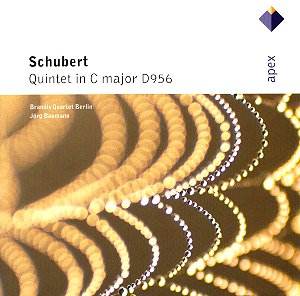 Composer: Franz Schubert
Composer: Franz Schubert
Works: String Quintet in C major
Performers: Brandis Quartet, Jörg Baumann (cello)
Recording: 1987, Teldec APEX 09274 08332 [54.56]
Label: Teldec
Schubert’s String Quintet in C major, completed in the waning weeks of his life in 1828, stands as a monumental testament to his introspective genius and mastery of chamber music. This work emerges not merely as a continuation of the classical quintet tradition initiated by Mozart but as a deeply personal expression, suffused with a profound sense of melancholy and lyrical beauty. Schubert’s choice to employ two cellos instead of a second viola creates a unique sound palette, allowing for rich harmonic interplay and emotional depth, qualities that the Brandis Quartet and cellist Jörg Baumann capture with sensitivity and skill.
The performance by the Brandis Quartet is marked by an exceptional understanding of Schubert’s nuanced intentions, particularly in the slow-moving lyrical passages that dominate the first two movements. The players exhibit a remarkable balance between activity and repose, achieving a dialogue that feels both conversational and expansive. This is evident in their treatment of the slow movement, where the sustained sonorities are caressed with a delicate touch, allowing the melodic lines to breathe without succumbing to excessive sentimentality. The contrast in the middle section is particularly illuminating; rather than altering the tempo, the ensemble shifts the emotional weight through dynamic shading, revealing the inner workings of Schubert’s harmonic language.
The technical prowess of the musicians comes to the fore in the final movements, where rhythmic vitality is paramount. The Brandis Quartet navigates the intricate interplay between the two cellos with finesse, deftly alternating between pizzicato and arco techniques. This attention to detail enhances the textural complexity of the work, ensuring that the rich sonorities do not overwhelm the rhythmic drive. The ensemble’s ability to maintain clarity amidst the lush harmonic backdrop is commendable, showcasing their deep musical understanding and collaborative synergy. The subtle interplay between the instruments reflects Schubert’s own duality: a blend of exuberance and introspection.
Recording quality plays an essential role in this interpretation. The engineering captures the rich tonal spectrum of the ensemble, allowing the listener to experience the layered textures of the music fully. The balance between the instruments is particularly well-executed, with the pizzicati of the cellos resonating clearly against the backdrop of the upper strings. While the recording dates back to 1987, it remains competitive with contemporary releases, offering a sonic depth that enhances the overall listening experience.
Comparisons with other notable recordings of Schubert’s Quintet, such as those by the Alban Berg Quartet or the Emerson String Quartet, reveal a distinct interpretative approach taken by the Brandis Quartet. While the former ensembles might emphasize a more vigorous, assertive style, the Brandis Quartet leans towards a reflective interpretation that privileges lyrical expression and harmonic exploration. This choice of interpretation invites listeners to engage with the music on a more introspective level, allowing for new insights and emotional connections.
The Brandis Quartet’s performance of Schubert’s String Quintet is a remarkable achievement, resonating with both technical excellence and profound musicality. Their interpretation invites listeners to explore the deeper emotional currents that flow through this late masterpiece, revealing its timeless beauty and complexity. This recording not only stands as a testament to the ensemble’s artistry but also reaffirms Schubert’s enduring legacy as a composer who transcended the boundaries of his time.



